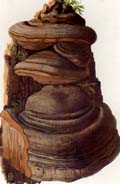 Key to Gilled Mushrooms Key
Key to Gilled Mushrooms KeyThis is a key to gilled mushrooms, that is, mushrooms having a definite cap with a fertile surface consisting of gills. The fruiting body usually also has a stem, although that may be lateral or absent (usually, then, the mushroom is growing from wood). You can use this key to identify mushrooms that you find.
 Polyporaceae Family
Polyporaceae FamilyFertile surface usually a layer of vertical tubes, of which the mouths are visible as pores on the underside of the cap or shelf.
Fruiting bodies usually tougher or harder than the "normal" gilled mushrooms, being leathery, corky, or woody. But they can be quite tender while actively growing
Once grown, they do not decay easily, remaining on the substrate for months or years
They often grow on wood, although a few are terrestrial (even those are usually growing on buried wood)
Fruiting body is usually a flat shelf, or hoof-shaped, protruding directly from the substrate, although sometimes it may have a short stalk.
Some forms never grow away from the substrate at all, so that all that is visible of the fruiting body are the pores.
Sometimes the pores are so minute that the fertile surface seems solid, until you look closely
 Lignicopolypore Subfamily
Lignicopolypore SubfamilyGrowing on wood
 Maze-o-porus Tribe
Maze-o-porus TribeFungi with a hymenophore of irregular, interweaving plates that divide the space between them into long, twisting chambers and maze-like passageways.
Usually the plates are quite hard and woody, sometimes just tough, never as soft and fragile as the gills on gilled mushrooms
Lenzites Genus Fries

Diagnosis
Narrow down your identification:
 Lenzites betulina
Lenzites betulinaCap grey to brownish, usually furry, zoned; sometimes greenish from algae growing on it






 Key to Gilled Mushrooms Key
Key to Gilled Mushrooms Key Polyporaceae Family
Polyporaceae Family
 Lenzites betulina
Lenzites betulina




